2013 NISSAN XTERRA mirror controls
[x] Cancel search: mirror controlsPage 162 of 394

OFF position (Indicator light off):
Outside air is drawn into the passenger compart-
ment and distributed through the selected outlet.
Use the off position for normal heater or air con-
ditioner operation.
Air conditioner button
Start the engine, turn the fan control dial to the
desired position and press the
button to
turn on the air conditioner. The indicator light
comes on when the air conditioner is operating.
To turn off the air conditioner, press the
button again.
The air conditioner cooling function oper-
ates only when the engine is running.
Rear window and outside mirror (if so
equipped) defroster switch
For more information about the rear window and
outside mirror (if so equipped) defroster switch,
see “Rear window and outside mirror defroster
switch” in the “Instruments and controls” section
of this manual.
HEATER OPERATION
Heating
This mode is used to direct heated air to the foot
outlets. Some air also flows from the defrost
outlets.
1. Press the
button to the OFF position
for normal heating. The indicator light on
the
button will go off.
2. Press the
air flow control button.
3.
Turn the fan control dial to the desired position.
4. Turn the temperature control dial to the de- sired position between the middle and the
hot position.
Ventilation
This mode directs outside air to the side and
center vents.
1. Press the
button to the OFF position.
The indicator light on the
button will
go off.
2. Press the
air flow control button.
3. Turn the fan control dial to the desired posi- tion.
4. Turn the temperature control dial to the de- sired position.
Defrosting or defogging
This mode directs the air to the defrost outlets to
defrost/defog the windows.
1. Press the defrost/defog button
.
2. Turn the fan control dial to the desired posi- tion.
3. Turn the temperature control dial to the de- sired position between the middle and the
hot position.
● To quickly remove ice or fog from the win-
dows, turn the fan control dial to the highest
setting and the temperature control to the
full HOT position.
● When the
position is selected, the air
conditioner automatically turns on (the indi-
cator light on the
button will come on)
if the outside temperature is more than 36°F
(2°C) . This dehumidifies the air which helps
defog the windshield. The
mode au-
tomatically turns off, allowing outside air to
be drawn into the passenger compartment
to further improve the defogging perfor-
mance.
Monitor, climate, audio, phone and voice recognition systems4-17
Page 169 of 394
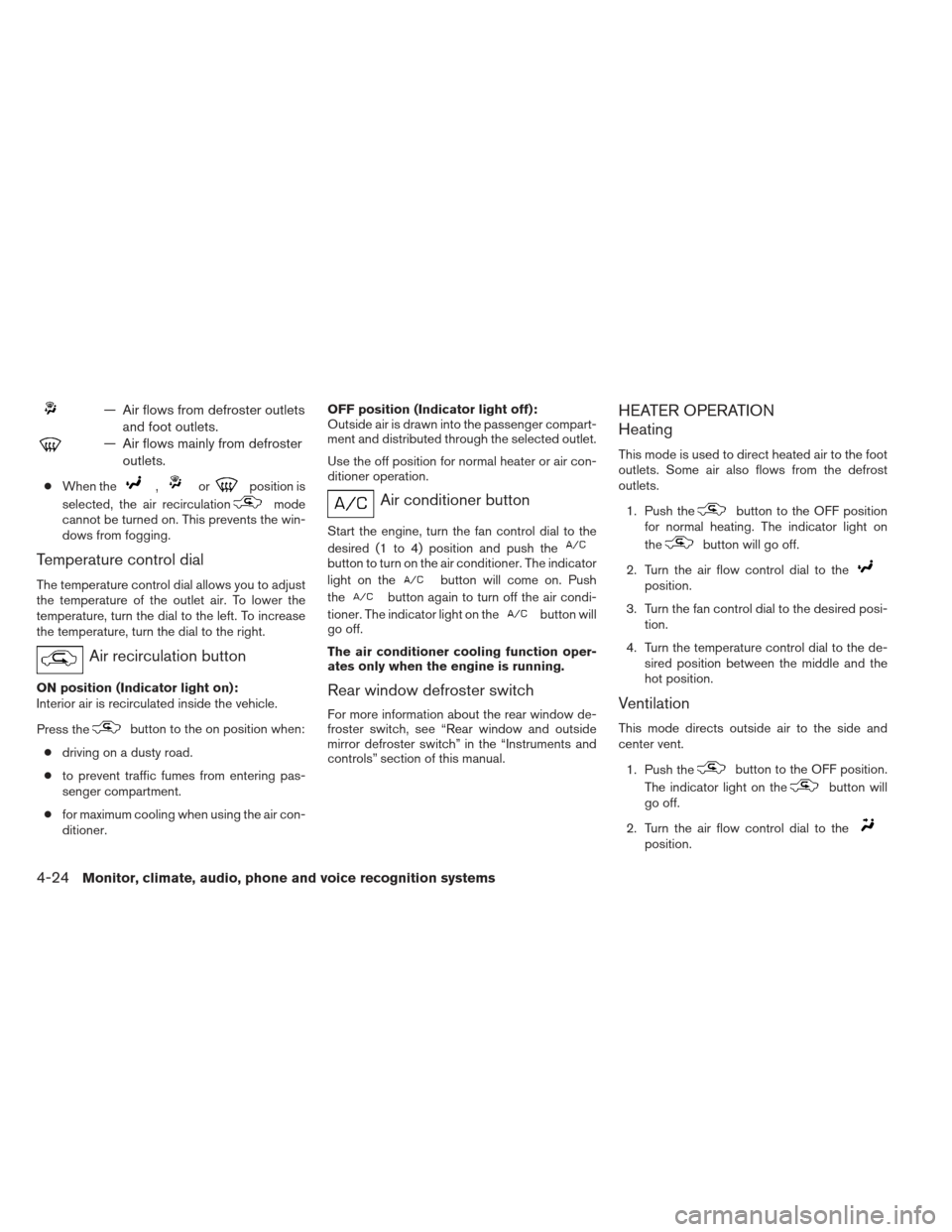
— Air flows from defroster outletsand foot outlets.
— Air flows mainly from defrosteroutlets.
● When the,orposition is
selected, the air recirculation
mode
cannot be turned on. This prevents the win-
dows from fogging.
Temperature control dial
The temperature control dial allows you to adjust
the temperature of the outlet air. To lower the
temperature, turn the dial to the left. To increase
the temperature, turn the dial to the right.
Air recirculation button
ON position (Indicator light on):
Interior air is recirculated inside the vehicle.
Press the
button to the on position when:
● driving on a dusty road.
● to prevent traffic fumes from entering pas-
senger compartment.
● for maximum cooling when using the air con-
ditioner. OFF position (Indicator light off):
Outside air is drawn into the passenger compart-
ment and distributed through the selected outlet.
Use the off position for normal heater or air con-
ditioner operation.
Air conditioner button
Start the engine, turn the fan control dial to the
desired (1 to 4) position and push the
button to turn on the air conditioner. The indicator
light on the
button will come on. Push
the
button again to turn off the air condi-
tioner. The indicator light on the
button will
go off.
The air conditioner cooling function oper-
ates only when the engine is running.
Rear window defroster switch
For more information about the rear window de-
froster switch, see “Rear window and outside
mirror defroster switch” in the “Instruments and
controls” section of this manual.
HEATER OPERATION
Heating
This mode is used to direct heated air to the foot
outlets. Some air also flows from the defrost
outlets.
1. Push the
button to the OFF position
for normal heating. The indicator light on
the
button will go off.
2. Turn the air flow control dial to the
position.
3. Turn the fan control dial to the desired posi- tion.
4. Turn the temperature control dial to the de- sired position between the middle and the
hot position.
Ventilation
This mode directs outside air to the side and
center vent.
1. Push the
button to the OFF position.
The indicator light on the
button will
go off.
2. Turn the air flow control dial to the
position.
4-24Monitor, climate, audio, phone and voice recognition systems
Page 259 of 394
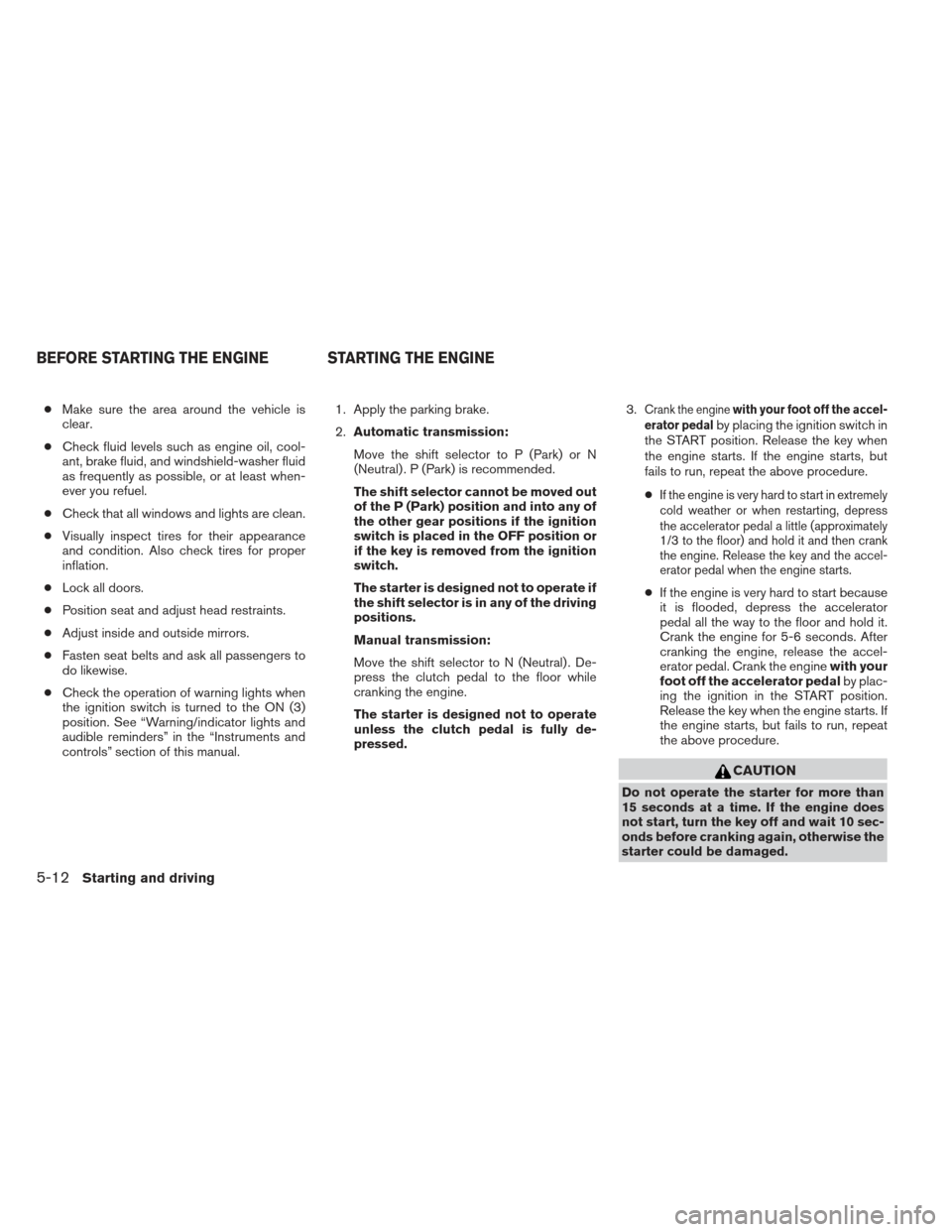
●Make sure the area around the vehicle is
clear.
● Check fluid levels such as engine oil, cool-
ant, brake fluid, and windshield-washer fluid
as frequently as possible, or at least when-
ever you refuel.
● Check that all windows and lights are clean.
● Visually inspect tires for their appearance
and condition. Also check tires for proper
inflation.
● Lock all doors.
● Position seat and adjust head restraints.
● Adjust inside and outside mirrors.
● Fasten seat belts and ask all passengers to
do likewise.
● Check the operation of warning lights when
the ignition switch is turned to the ON (3)
position. See “Warning/indicator lights and
audible reminders” in the “Instruments and
controls” section of this manual. 1. Apply the parking brake.
2.
Automatic transmission:
Move the shift selector to P (Park) or N
(Neutral) . P (Park) is recommended.
The shift selector cannot be moved out
of the P (Park) position and into any of
the other gear positions if the ignition
switch is placed in the OFF position or
if the key is removed from the ignition
switch.
The starter is designed not to operate if
the shift selector is in any of the driving
positions.
Manual transmission:
Move the shift selector to N (Neutral) . De-
press the clutch pedal to the floor while
cranking the engine.
The starter is designed not to operate
unless the clutch pedal is fully de-
pressed. 3.Crank the engine
with your foot off the accel-
erator pedalby placing the ignition switch in
the START position. Release the key when
the engine starts. If the engine starts, but
fails to run, repeat the above procedure.
●
If the engine is very hard to start in extremely
cold weather or when restarting, depress
the accelerator pedal a little (approximately
1/3 to the floor) and hold it and then crank
the engine. Release the key and the accel-
erator pedal when the engine starts.
● If the engine is very hard to start because
it is flooded, depress the accelerator
pedal all the way to the floor and hold it.
Crank the engine for 5-6 seconds. After
cranking the engine, release the accel-
erator pedal. Crank the engine with your
foot off the accelerator pedal by plac-
ing the ignition in the START position.
Release the key when the engine starts. If
the engine starts, but fails to run, repeat
the above procedure.
CAUTION
Do not operate the starter for more than
15 seconds at a time. If the engine does
not start, turn the key off and wait 10 sec-
onds before cranking again, otherwise the
starter could be damaged.
BEFORE STARTING THE ENGINE STARTING THE ENGINE
5-12Starting and driving
Page 379 of 394
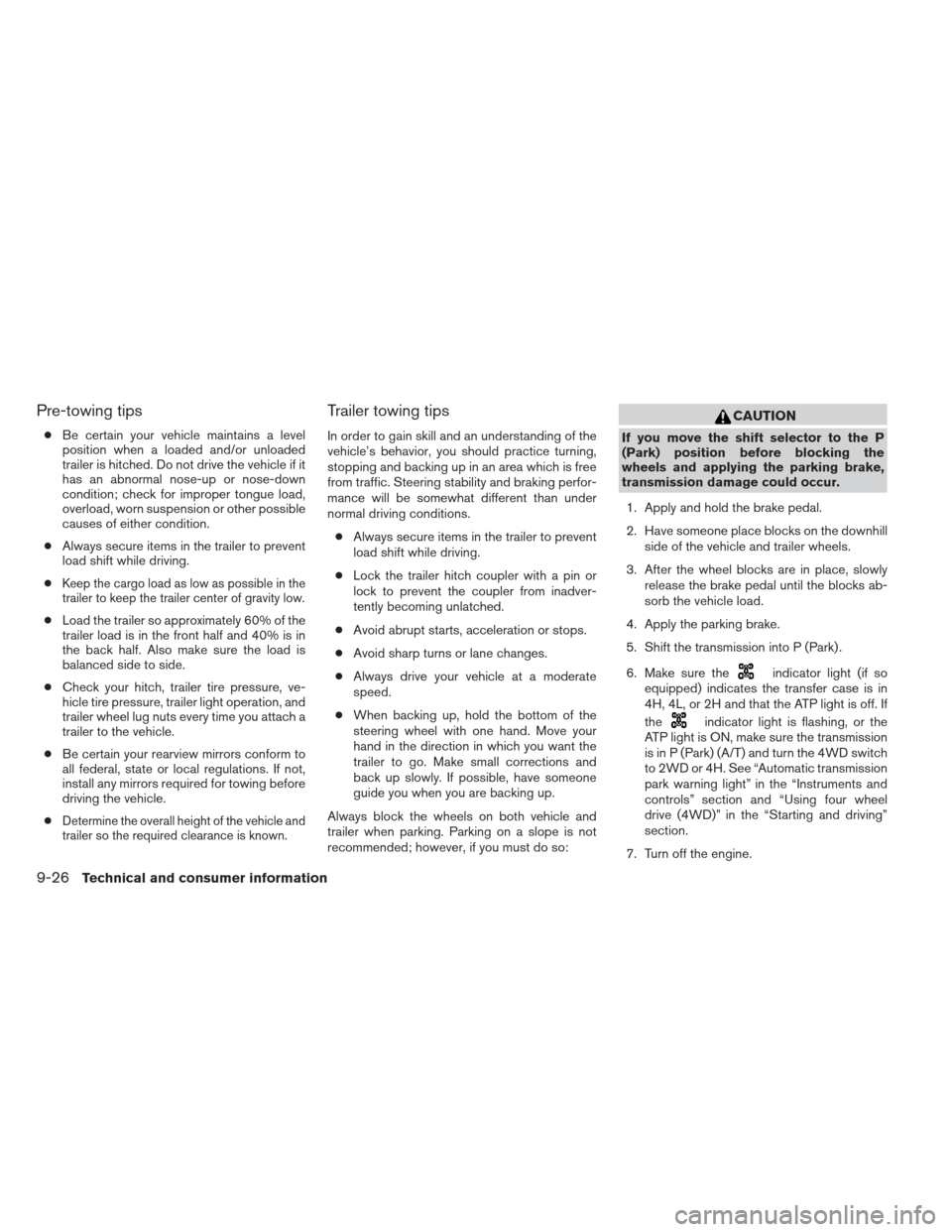
Pre-towing tips
●Be certain your vehicle maintains a level
position when a loaded and/or unloaded
trailer is hitched. Do not drive the vehicle if it
has an abnormal nose-up or nose-down
condition; check for improper tongue load,
overload, worn suspension or other possible
causes of either condition.
● Always secure items in the trailer to prevent
load shift while driving.
●
Keep the cargo load as low as possible in the
trailer to keep the trailer center of gravity low.
● Load the trailer so approximately 60% of the
trailer load is in the front half and 40% is in
the back half. Also make sure the load is
balanced side to side.
● Check your hitch, trailer tire pressure, ve-
hicle tire pressure, trailer light operation, and
trailer wheel lug nuts every time you attach a
trailer to the vehicle.
● Be certain your rearview mirrors conform to
all federal, state or local regulations. If not,
install any mirrors required for towing before
driving the vehicle.
●
Determine the overall height of the vehicle and
trailer so the required clearance is known.
Trailer towing tips
In order to gain skill and an understanding of the
vehicle’s behavior, you should practice turning,
stopping and backing up in an area which is free
from traffic. Steering stability and braking perfor-
mance will be somewhat different than under
normal driving conditions.
● Always secure items in the trailer to prevent
load shift while driving.
● Lock the trailer hitch coupler with a pin or
lock to prevent the coupler from inadver-
tently becoming unlatched.
● Avoid abrupt starts, acceleration or stops.
● Avoid sharp turns or lane changes.
● Always drive your vehicle at a moderate
speed.
● When backing up, hold the bottom of the
steering wheel with one hand. Move your
hand in the direction in which you want the
trailer to go. Make small corrections and
back up slowly. If possible, have someone
guide you when you are backing up.
Always block the wheels on both vehicle and
trailer when parking. Parking on a slope is not
recommended; however, if you must do so:
CAUTION
If you move the shift selector to the P
(Park) position before blocking the
wheels and applying the parking brake,
transmission damage could occur.
1. Apply and hold the brake pedal.
2. Have someone place blocks on the downhill side of the vehicle and trailer wheels.
3. After the wheel blocks are in place, slowly release the brake pedal until the blocks ab-
sorb the vehicle load.
4. Apply the parking brake.
5. Shift the transmission into P (Park) .
6. Make sure the
indicator light (if so
equipped) indicates the transfer case is in
4H, 4L, or 2H and that the ATP light is off. If
the
indicator light is flashing, or the
ATP light is ON, make sure the transmission
is in P (Park) (A/T) and turn the 4WD switch
to 2WD or 4H. See “Automatic transmission
park warning light” in the “Instruments and
controls” section and “Using four wheel
drive (4WD)” in the “Starting and driving”
section.
7. Turn off the engine.
9-26Technical and consumer information
Page 386 of 394
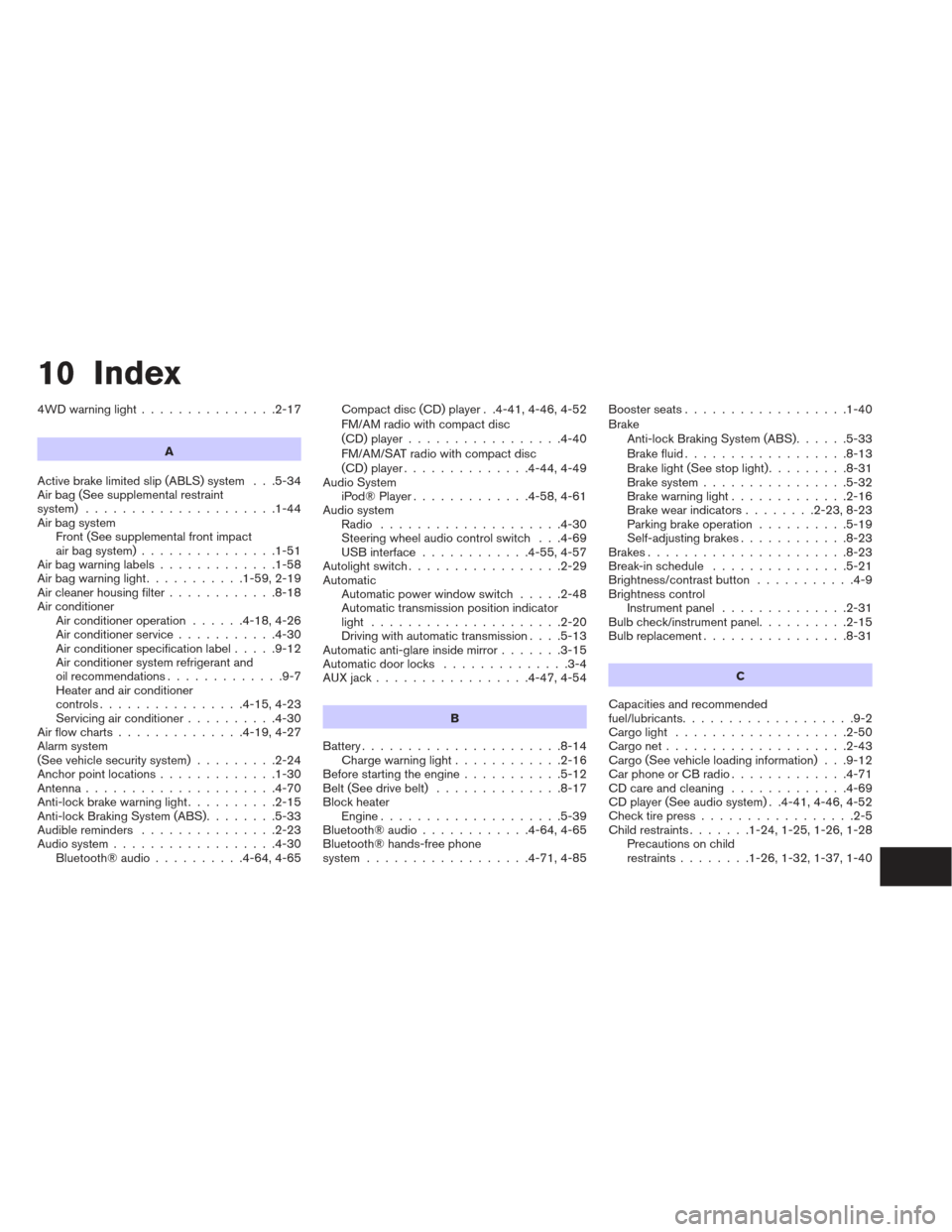
10 Index
4WDwarninglight...............2-17A
Active brake limited slip (ABLS) system . . .5-34
Air bag (See supplemental restraint
system) .....................1-44
Air bag system Front (See supplemental front impact
air bag system) ...............1-51
Airbagwarninglabels.............1-58
Airbagwarninglight...........1-59,2-19
Air cleaner housing filter ............8-18
Air conditioner Air conditioner operation ......4-18,4-26
Air conditioner service ...........4-30
Air conditioner specification label .....9-12
Air conditioner system refrigerant and
oil recommendations .............9-7
Heater and air conditioner
controls................4-15,4-23
Servicing air conditioner ..........4-30
Airflowcharts..............4-19,4-27
Alarm system
(See vehicle security system) .........2-24
Anchor point locations .............1-30
Antenna.....................4-70
Anti-lock brake warning light ..........2-15
Anti-lock Braking System (ABS) ........5-33
Audible reminders ...............2-23
Audio system ..................4-30
Bluetooth®audio..........4-64,4-65 Compact disc (CD) player . .4-41, 4-46, 4-52
FM/AM radio with compact disc
(CD) player
.................4-40
FM/AM/SAT radio with compact disc
(CD) player ..............4-44,4-49
Audio System iPod®Player.............4-58,4-61
Audio system Radio ....................4-30
Steering wheel audio control switch . . .4-69
USB interface ............4-55,4-57
Autolight switch .................2-29
Automatic Automatic power window switch .....2-48
Automatic transmission position indicator
light .....................2-20
Driving with automatic transmission ....5-13
Automatic anti-glare inside mirror .......3-15
Automatic door locks ..............3-4
AUXjack.................4-47,4-54
B
Battery ......................8-14
Chargewarninglight............2-16
Before starting the engine ...........5-12
Belt (See drive belt) ..............8-17
Block heater Engine ....................5-39
Bluetooth®audio............4-64,4-65
Bluetooth® hands-free phone
system ..................4-71,4-85 Boosterseats..................1-40
Brake
Anti-lock Braking System (ABS) ......5-33
Brakefluid..................8-13
Brakelight(Seestoplight).........8-31
Brake system ................5-32
Brake warning light .............2-16
Brake wear indicators ........2-23,8-23
Parking brake operation ..........5-19
Self-adjusting brakes ............8-23
Brakes ......................8-23
Break-inschedule ...............5-21
Brightness/contrast button ...........4-9
Brightness control Instrument panel ..............2-31
Bulb check/instrument panel ..........2-15
Bulbreplacement................8-31
C
Capacities and recommended
fuel/lubricants ...................9-2
Cargolight ...................2-50
Cargonet....................2-43
Cargo (See vehicle loading information) . . .9-12
CarphoneorCBradio.............4-71
CDcareandcleaning .............4-69
CD player (See audio system) . .4-41, 4-46, 4-52
Check tire press .................2-5
Child restraints .......1-24,1-25,1-26,1-28
Precautions on child
restraints ........
1
-26,1-32,1-37,1-40
Page 387 of 394
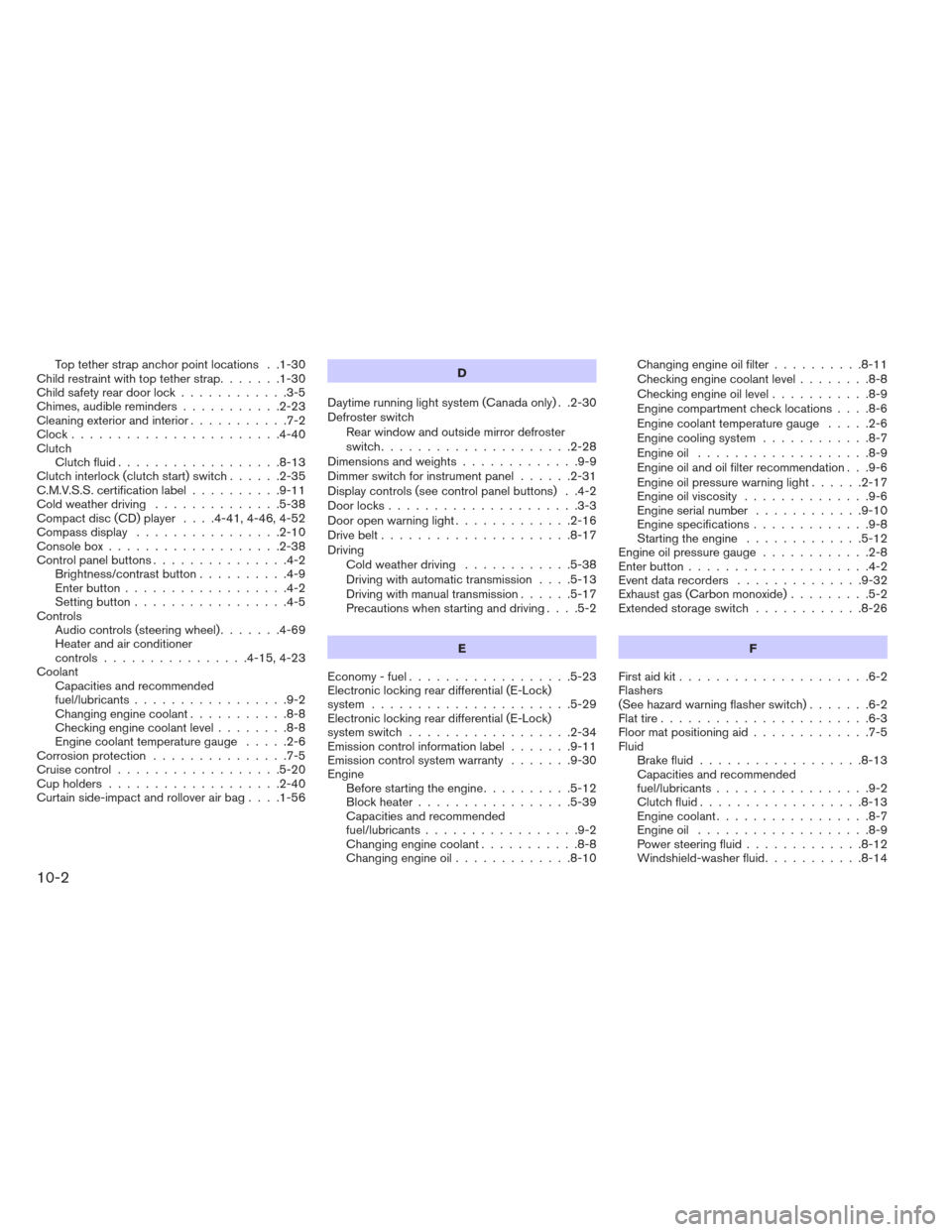
Top tether strap anchor point locations . .1-30
Child restraint with top tether strap .......1-30
Child safety rear door lock ............3-5
Chimes, audible reminders ...........2-23
Cleaningexteriorandinterior...........7-2
Clock.......................4-40
Clutch Clutchfluid..................8-13
Clutchinterlock(clutchstart)switch......2-35
C.M.V.S.S. certification label ..........9-11
Cold weather driving ..............5-38
Compact disc (CD) player ....4-41,4-46,4-52
Compass display ................2-10
Console box ...................2-38
Controlpanelbuttons...............4-2 Brightness/contrast button ..........4-9
Enterbutton..................4-2
Setting button .................4-5
Controls Audiocontrols(steeringwheel).......4-69
Heater and air conditioner
controls ................4-15,4-23
Coolant Capacities and recommended
fuel/lubricants .................9-2
Changing engine coolant ...........8-8
Checking engine coolant level ........8-8
Engine coolant temperature gauge .....2-6
Corrosionprotection ...............7-5
Cruise control ..................5-20
Cupholders...................2-40
Curtain side-impact and rollover air bag ....1-56D
Daytime running light system (Canada only) . .2-30
Defroster switch Rear window and outside mirror defroster
switch.....................2-28
Dimensionsandweights.............9-9
Dimmer switch for instrument panel ......2-31
Display controls (see control panel buttons) . .4-2
Door locks .....................3-3
Door open warning light .............2-16
Drive belt .....................8-17
Driving Cold weather driving ............5-38
Driving with automatic transmission ....5-13
Driving with manual transmission ......5-17
Precautions when starting and driving ....5-2
E
Economy - fuel ..................5-23
Electronic locking rear differential (E-Lock)
system ......................5-29
Electronic locking rear differential (E-Lock)
system switch ..................2-34
Emission control information label .......9-11
Emission control system warranty .......9-30
Engine Before starting the engine ..........5-12
Block heater .................5-39
Capacities and recommended
fuel/lubricants .................9-2
Changing engine coolant ...........8-8
Changing engine oil .............8-10 Changing engine oil filter
..........8-11
Checking engine coolant level ........8-8
Checking engine oil level ...........8-9
Engine compartment check locations ....8-6
Engine coolant temperature gauge .....2-6
Engine cooling system ............8-7
Engine oil ...................8-9
Engine oil and oil filter recommendation . . .9-6
Engine oil pressure warning light ......2-17
Engine oil viscosity ..............9-6
Engine serial
number ............9-10
Engine specifications .............9-8
Starting the engine .............5-12
Engine oil pressure gauge ............2-8
Enterbutton....................4-2
Eventdatarecorders ..............9-32
Exhaust gas (Carbon monoxide) .........5-2
Extended storage switch ............8-26
F
First aid kit .....................6-2
Flashers
(See hazard warning flasher switch) .......6-2
Flat tire .......................6-3
Floor mat positioning aid .............7-5
Fluid Brake fluid ..................8-13
Capacities and recommended
fuel/lubricants .................9-2
Clutch fluid ..................8-13
Engine coolant .................8-7
Engine oil ...................8-9
Power steering fluid .............8-12
Windshield-washer fluid ...........8-14
10-2
Page 388 of 394
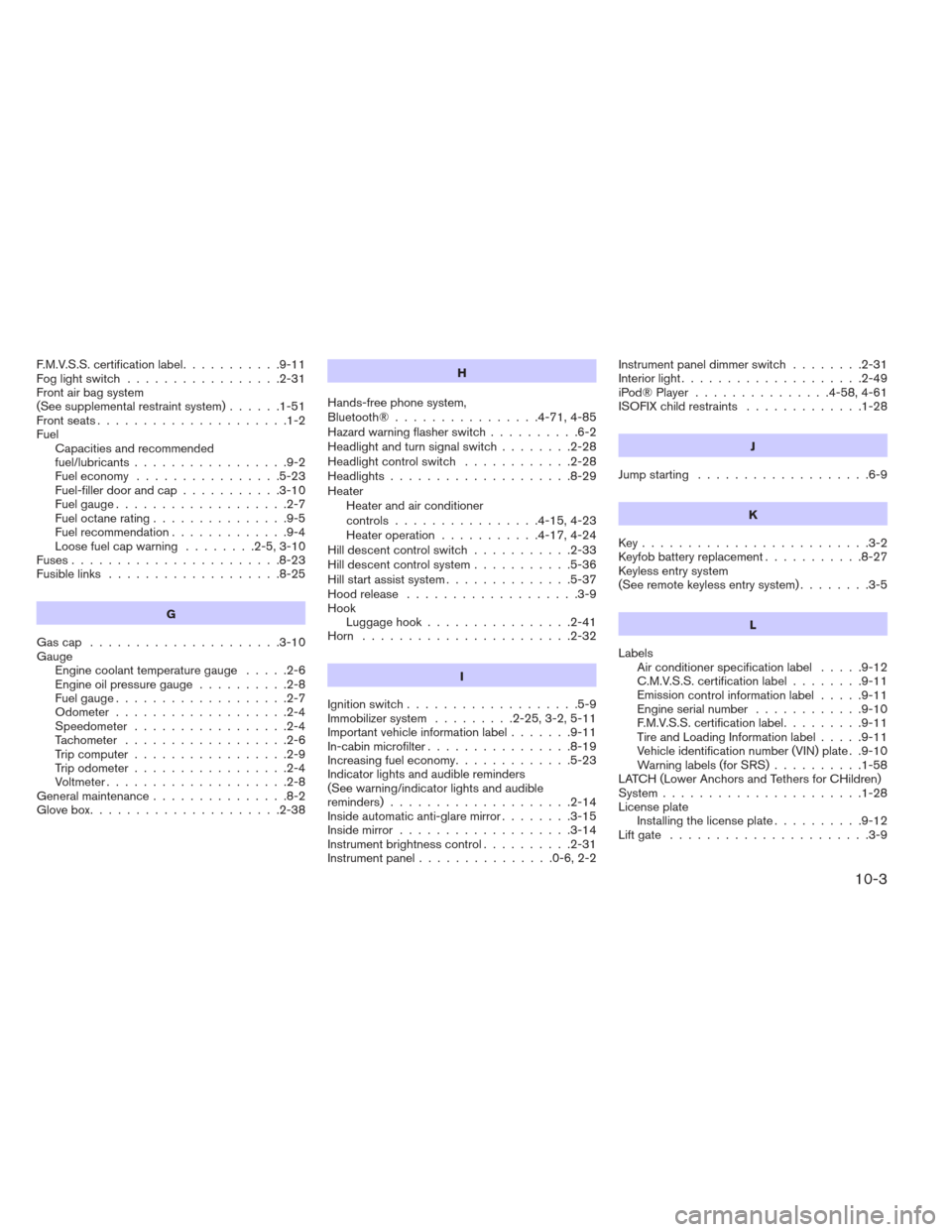
F.M.V.S.S. certification label...........9-11
Foglightswitch .................2-31
Front air bag system
(See supplemental restraint system) ......1-51
Frontseats.....................1-2
Fuel Capacities and recommended
fuel/lubricants .................9-2
Fuel economy ................5-23
Fuel-filler door and cap ...........3-10
Fuel gauge ...................2-7
Fueloctanerating...............9-5
Fuel recommendation .............9-4
Loosefuelcapwarning ........2-5,3-10
Fuses.......................8-23
Fusiblelinks ...................8-25
G
Gascap .....................3-10
Gauge Engine coolant temperature gauge .....2-6
Engine oil pressure gauge ..........2-8
Fuel gauge ...................2-7
Odometer ...................2-4
Speedometer .................2-4
Tachometer ..................2-6
Trip computer .................2-9
Trip odometer .................2-4
Voltmeter....................2-8
Generalmaintenance...............8-2
Glovebox.....................2-38 H
Hands-free phone system,
Bluetooth®................4-71,4-85
Hazard warning flasher switch ..........6-2
Headlight and turn signal switch ........2-28
Headlight control switch ............2-28
Headlights ....................8-29
Heater Heater and air conditioner
controls................4-15,4-23
Heater operation ...........4-17,4-24
Hill descent control switch ...........2-33
Hill descent control system ...........5-36
Hill start assist system ..............5-37
Hood release ...................3-9
Hook Luggagehook................2-41
Horn .......................2-32
I
Ignition switch ...................5-9
Immobilizer system .........2-25,3-2,5-11
Important vehicle information label .......9-11
In-cabin microfilter ................8-19
Increasing fuel economy .............5-23
Indicator lights and audible reminders
(See warning/indicator lights and audible
reminders)....................2-14
Inside automatic anti-glare mirror ........3-15
Inside mirror ...................3-14
Instrument brightness control ..........2-31
Instrument panel ...............0-6,2-2 Instrument panel dimmer switch
........2-31
Interiorlight....................2-49
iPod® Player ...............4-58,4-61
ISOFIX child restraints .............1-28
J
Jump starting ...................6-9
K
Key.........................3-2
Keyfob battery replacement ...........8-27
Keyless entry system
(See remote keyless entry system) ........3-5
L
Labels Air conditioner specification label .....9-12
C.M.V.S.S. certification label ........9-11
Emission control
information label .....9-11
Engine serial number ............9-10
F.M.V.S.S. certification label .........9-11
Tire and Loading Information label .....9-11
Vehicle identification number (VIN) plate . .9-10
Warning labels (for SRS) ..........1-58
LATCH (Lower Anchors and Tethers for CHildren)
System ......................1-28
License plate Installing the license plate ..........9-12
Liftgate ......................3-9
10-3
Page 389 of 394

LightAirbagwarninglight.........1-59,2-19
Brakelight(Seestoplight).........8-31
Bulb check/instrument panel ........2-15
Bulb replacement ..............8-31
Chargewarninglight ............2-16
Foglightswitch ...............2-31
Headlight and turn signal switch ......2-28
Headlightcontrolswitch ..........2-28
Headlights..................8-29
Interiorlight..................2-49
Lightbulbs..................8-29
Low tire pressure warning light .......2-17
Low windshield-washer fluid warning
light......................2-19
Offroadlampsswitch............2-32
Passenger air bag and status light .....1-53
Security indicator light ............2-22
Warning/indicator lights and audible
reminders ...................2-14
Lights Maplights ..................2-50
Lock Child safety rear door lock ..........3-5
Door locks ...................3-3
Power door locks ...............3-4
Loose fuel cap warning ..........2-5,3-10
Lowfuelwarninglight..............2-17
Low tire pressure warning light .........2-17
Low windshield-washer fluid warning light . . .2-19
Luggage hook ..................2-41
Luggage rack (see roof rack) ..........2-44
Luggage (See vehicle loading information) . .9-12
Luggage storage
(seevehicleloadinginformation)........2-41 M
Maintenance Generalmaintenance.............8-2
Insidethevehicle...............8-3
Maintenance precautions ...........8-5
Outside the vehicle ..............8-2
Seatbeltmaintenance............1-23
Underthehoodandvehicle .........8-4
Malfunction indicator light ............2-21
Manual front seat adjustment ...........1-2
Maplights ....................2-50
Map pocket ....................2-39
Meters and gauges ................2-3
Instrument brightness control ........2-31
Mirror Automatic anti-glare inside mirror ......3-15
Inside mirror .................3-14
Outside mirrors ...............3-15
Vanity mirror .................3-14
Multi-remote control system
(See remote keyless entry system) ........3-5
N
NISSAN vehicle immobilizer
system ................2-25,3-2,5-11
NISSAN voice recognition system .......4-95
O
Octane rating (See fuel octane rating) ......9-5
Odometer .....................2-4
Offroadlampsswitch..............2-32 Oil
Capacities and recommended
fuel/lubricants .................9-2
Changingengineoil.............8-10
Changing engine oil filter ..........8-11
Checking engine oil level ...........8-9
Engine oil ...................8-9
Engine oil and oil filter recommendation . . .9-6
Engine oil viscosity ..............9-6
Outside mirrors .................3-15
Overdrive switch .................5-17
Overheat If your vehicle overheats ...........6-11
Owner’s manual order form ...........9-32
Owner’s manual/service manual order
information ....................9-32
P
Parking Parking brake operation ...........5-19
Parking/parking on hills ...........5-31
Phone, Bluetooth® hands-free
system ................... 4
-71,4-85
Power Power door locks ...............3-4
Power outlet .................2-36
Power rear windows .............2-48
Power steering fluid .............8-12
Power steering system ...........5-32
Power windows ...............2-47
Rear power windows ............2-48
Precautions Maintenanceprecautions...........8-5
10-4